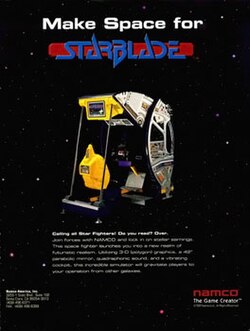Starblade
| StarBlade | |
|---|---|
 | |
| Developer(s) | Namco |
| Publisher(s) | Namco |
| Platform(s) | Arcade Sega CD 3DO PlayStation PlayStation 2 * *freebie with Tekken 5 |
| Release | 1991 |
| Genre(s) | Shoot'em up |
| Mode(s) | Single Player |
| Arcade system | Namco System 21 |
StarBlade (スターブレード, sutā burēdo) is a shoot 'em up arcade game that was released by Namco in 1991. It was later ported to the Sega CD in 1994, and became available on the 3DO in 1995. It was also released on the PlayStation as StarBlade Alpha in 1996.
Arcade
Starblade was *the* space simulator of all time. The appearance of a "pod" in which the "gunner" controlled a double barrel laser canon, was not a totally new concept in the arcades, but what was new (in the arcades anyway) was the method of how the image was "projected". The arcade version of Starblade used a concave mirror (molded of black, reflective, and quite flexible plexi) to reflect the image of a 26" standard resolution monitor at the top of the simulator housing. This gave the player an experience of a deeper space environment which, with its lens like effect had never been seen in any videogame.
The player had a large and heavy 2-axis/4-button controller (laser-gun) which had a built-in red multi-LED lamp that flashed as enemies were destroyed. When the player got hit by enemy fire the seat would rumble and a couple of intense flashing strobes (like photo flashes) would temporarily blind the player. A 30VDC motor with an asymmetrical axis produced the seat shaking effect as the seat module was resting upon three rubber cylinders that allowed the seat certain movement.
The sound was a surround type sound with four speakers. Two in the front below the large mirror, and two in the back of the seat. The US version cabinet had the rear speakers tucked into its monitor-box at the top (behind the yellow plasitc cover, you can see the grilles). The pre-amped audio signal from the game board was actually only two channels, but since Starblade uses a specially designed amplifier pcb the audio is separated into four individual channels.
There was a "sequel" to Starblade which was called Starblade: Operation Blue Planet, but because of the game never made production, it makes it pretty much irrelevant. The prototype was running in the Namco O.R.B.S. cabinet which used a projector on a global shaped surface and a "slide in" seat module (the player was completely immersed), and a modified System 246 hardware for the computing.
Starblade also came in one other incarnation called Galaxian3 Project Dragoon. This was a multi-player (6 players maximum) "Theater 6" large scale attraction. It used two Sony CRT projectors with two laser disc players (these played the background/scenery motion) plus some CG rendering hardware (running the interactive front layer with enemy ships) to produce the wide screen space battle scenarios. The actual game was not much different from Starblade, in fact several ingame voices are straight copies from Starblade, like "Making a rapid descent". The path of the game seems almost like a laser-disc remake of the original Starblade game as you start off in space, battling through an asteroid field, destroying some battleships and then descending onto a red planet (Redeye? again?) where you fly through desert canyons, finishing off inside a power station of a gigantic enemy weapon. Even the music was a rearrangement of the Starblade music.
There was also an upgrade for Theater 6 called Attack of the Zolgear which had a totally different story, more elaborate with longer play time. Nevertheless, it inherited with the elements from Starblade.
In 2005, Starblade was shown in Tekken 5 during the opening loading screen, and as an unlockable classic game in the Arcade History section in the game.
StarBlade makes an appearance in Ridge Racer 7 as the wheels manufacturer and features varieties of wheels from the game.
Enhanced ports
On the PlayStation (StarBlade Alpha) and 3DO versions, players could chose from the arcade version of the game and an enhanced version. In the arcade mode, graphics are made of flat polygons and the playing screen contains little black bars on the left and right edge of the screen. For the enhanced mode, the games graphics are made up of fully textured polygons with a fullscreen view of the action.
Technical Info
The game runs on the Namco System 21 hardware.
Sequel
A sequel titled StarBlade: Operation Blue Planet was developed in 2002, and ran in the Namco System 246 hardware. It never made past field testing. [1]
External links
- Review by 3DOkid (3DO version)
